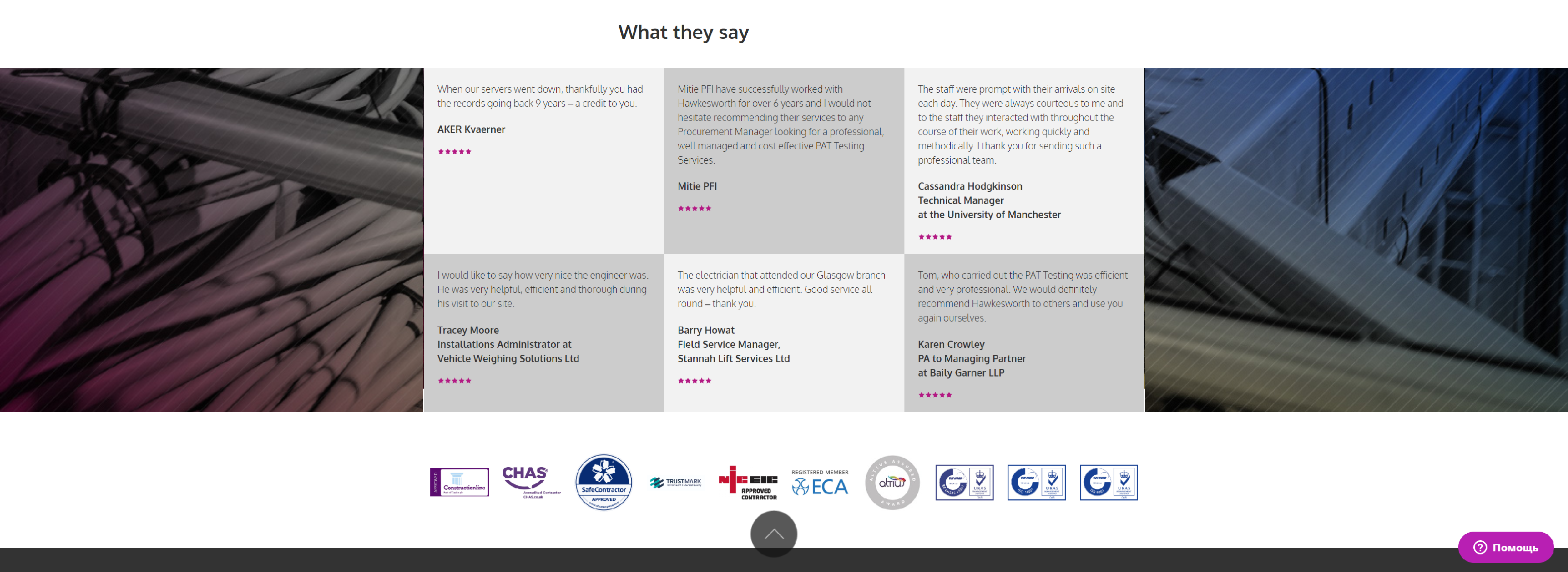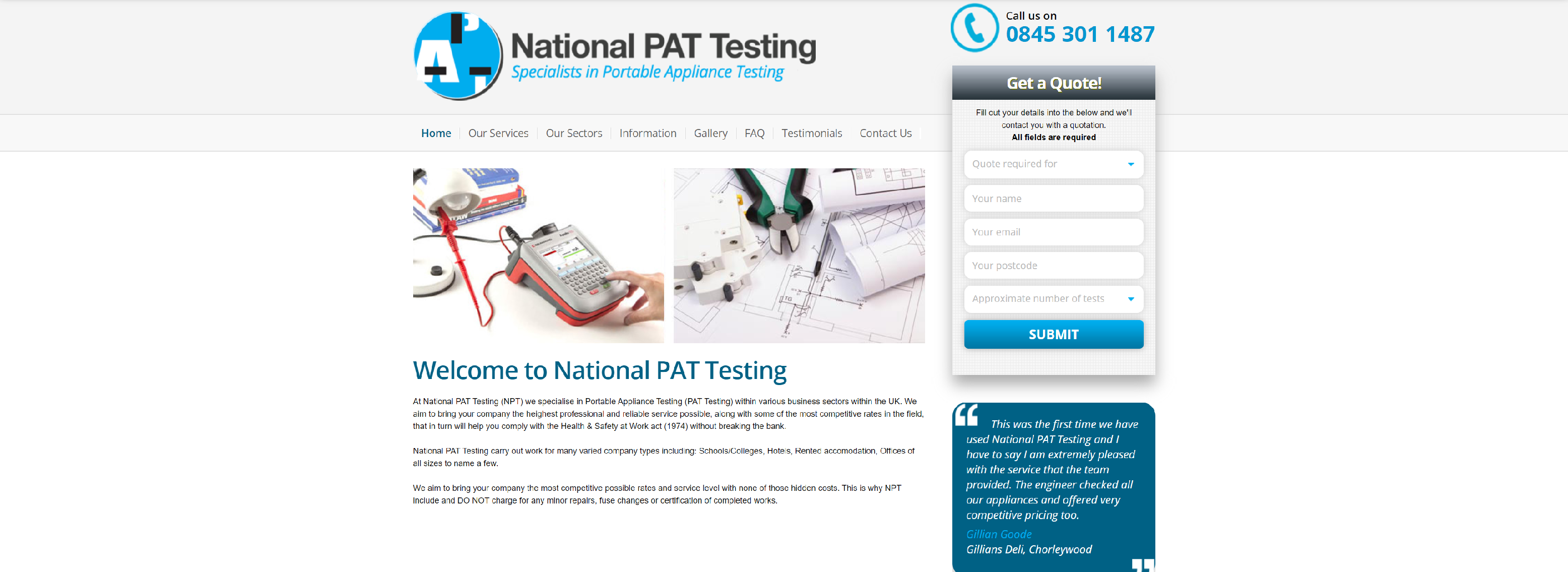PAT Testing is short for Portable Appliance Testing. Like Liquid Crystal Display has become known as LCD display (duplicating the “D”), Portable Appliance Testing has become known as PAT Testing (duplicating the “T”).
Why is PAT Testing needed?
UK Health and Safety legislation places a responsibility on organisations (and in some cases, individuals) to ensure that electrical equipment within their premises, or electrical equipment provided by them for use by their employees, customers, visitors or patients is safe to use.
The Institution of Engineering and Technology (formerly known as the Institution of Electrical Engineers or IEE) has compiledthe Code of Practice for In-service Inspection and Testing of Electrical Equipment (more commonly known as PAT Testing). This code of practice provides the recognised methods of ensuringthat electrical equipment is fit for continued service or whether maintenance or replacement of it is necessary.
Is PAT Testing compulsory?
PAT Testing itself is not compulsory, however, ensuring that your electrical appliances are safe is compulsory and the recognised way of doing this is through In-service Inspection and Testing (more commonly known as PAT Testing).
PAT Testing is a statutoryrequirement and many insurance companies require the insured to comply with all current regulations. This includes the Electricity at Work Regulations 1989, which state that “As may be necessary to prevent danger, all systems shall be maintained so as to prevent, so far as reasonably practicable, such danger” (Regulation 4(2)). “Electrical equipment includes anything used, intended to be used or installed for use, to generate, provide, transmit, transform, rectify, convert, conduct, distribute, control, store, measure or use electrical energy.” (Regulation 2(1)).
The responsibility on the employer to ensure work equipment is safe is also covered by The Provision and Use of Work Equipment Regulations 1998. This states that “Every employer shall ensure that work equipment is so constructed or adapted as to be suitable for the purpose for which it is used or provided.” (Regulation 4(1)). This includes all work equipment (fixed, portable or transportable) connected to a source of electrical energy.”
Failure to comply with Electrical Regulations can lead to a maximum penalty of a £5,000 fine and/or up to six months imprisonment. For breaches under the general duties of the Health Safety at Work Act 1974, penalties of up to £20,000 were introduced in 1992 and offences heard on indictment in the Crown Court attract unlimited financial penalties and up to two years imprisonment.
Who has responsibilities when it comes to electrical equipment in my organisation?
Within an organisation, the following people all have responsibilities for electrical equipment:
- Users of electrical equipment (who must carry out user checks prior to using the equipment)
- Administrators with responsibility for electrical maintenance (typically people with no technical knowledge)
- The competent person that carries out the formal visual inspections and the actual PAT Testing
- Other duty-holders such as company owners, directors, managers and building services managers
So, by PAT Testing every year, will I fully comply with the Code of Practice?
No! Many Electricians and PAT Testing organisations will gladly turn up at your site once a year and take payment for performing the role of “The Competence Person” by carrying out the formal visual inspections and conducting the actual PAT Testing procedures. This fulfils only part of your responsibilities!
What is included in our PAT Testing Service?
Many people believe that PAT Testing is simply the act of plugging the appliance into a PAT Tester, running a few tests and printing a Passed or Fail label. This is totally incorrect! The actual act of PAT testing appliances using a test meter is only part of what should be done by the competent person when theycome to your site to perform” PAT Testing”. The majority of the time spent on site is conducting the formal visual inspections.
If PAT Testing is done properly, this is what you should expect the competent person to dofor each appliance:
Formal inspection
- Disconnect the equipment by switching off and unplugging it
- Make sure that the plug is not loose in the socket, that it can be removed from the socket without difficulty, that there areno cracks or damage, no sign of over-heating and that the flex is secure in its anchorage. The pins of the plug should be straight and ideally sleeved. There should be no cardboard label on the bottom of the plug and it should not rattle.
- The top of the plug should be removed and the connections should be inspected. Each screw terminal should be tight and the rating of the fuse should be checked.
- The cable should be inspected to ensure that it is in good condition with no cuts, fraying or damage, that it is not in a location where it could be damaged, that it is of the correct length and that there are no taped joints. It should also not be run under carpet, be bent too tightly or be in a position where it presents a trip hazard
- The socket should securely fixed in place and it should be checked for damage, signs of over-heating and the switch should be checked for correct operation
- The appliance itself should be checked for damage to the casing , that it is able to be used safely, that it switches on and off correctly and that it works properly. It should also be checked to ensure that there is sufficient space around it to allow ventilation and cooling, that there is no sign of overheating and that it is positioned somewhere that liquids will not easily be spilt into it
- The equipment should be suitable for the environment in which it is being used (eg. an indoor appliance is not being used outdoors) and that it is suitable for the work it is required to carry out (a light duty domestic appliance is not being used in a heavy duty commercial environment), that there is no indiscriminate use of extensions leads and multi-way adaptors and that the equipment is not normally left on overnight.
- Make sure that the voltage, frequency and current requirements of the appliance are acceptable for the supply
- Consider whether the equipment being inspected is suitable for the environment it is being used in and for the nature of workbeing undertaken
- Determine that, where needed, there is a means for switching the appliance off during normal use, for routine maintenance andin the event of an emergency
- Seek permission from the responsible person to switch off the appliance in question (all equipment will need to be powered down in order to carry out the testing)
- Check the operation of any safety switches or devices such as those fitted on the base of halogen heaters to ensure that theyturn off if they fall over
- Speak to the regular user and ask them if there are any problems or intermittent faults with the appliance that they are aware of
Testing
Once all of the above has been done, the testing can begin and this should include as a minimum:
- Obtain a copy of the previous test results and compare these with the current results in order to identify any deterioration
- Use of a PAT Tester to conduct an earth continuity test (where the appliance is of Class1 and should be earthed) to ensure that the earth is functioning correctly
- Use of a PAT Tester to conduct a polarity check to ensure that the appliance is correctly wired
- Use of a PAT Tester to conduct an insulation resistance test to ensure that the insulation within the flex and the appliance is intact and is not breaking down
- Carry out a functional check where the appliance is briefly powered up and checked to ensure it is working correctly
- Writing out or printing and affixing a label to certify that the appliance has passed all of the tests and is safe to use at that moment in time.
- Compilation of an Equipment Register, a Combined Inspection and Test Record, a Repair Register and a Faulty Equipment Register
As you can see, actual “PAT Testing” is only a very small part of what your “PAT testing operative” or “competent person” should do when on your site!! If they are complying with the code of practice, they should be performing all of the above activities.
Who should I get to do my PAT Testing?
Anyone can buy a PAT tester and offer “PAT Testing Services”.
The Code of Practice states that the person performing the inspections and conducting the testing must posses sufficient technical knowledge or experience to be capable of ensuring that injury is prevented. It also states that electrical testing should be performed by a person who is competent in the safe useof the test equipment and who knows how to interpret the results obtained. This person should be capable of inspecting the equipment and , where necessary, dismantling it to check the cable connections.
What types of appliances need testing?
Basically, any type of equipment, which is powered by electrical energy. The Code of Practice states that the following types of appliances should be inspected and tested as described above:-
Portable Appliances
An appliance of less than 18 kg in mass that is intended to be moved while in operation or an appliance which can easily be moved from one place to another, e.g. kettle, toaster, food mixer, vacuum cleaner, fan heater.
Movable Equipment
Equipment which is either 18 kg or less in mass and not fixed, e.g. an electric fire, small welder etc. or equipment with wheels, castors or other means to facilitate movement by the operator as required to perform its intended use, e.g. air conditioning unit.
Hand-held Appliances
Portable equipment intended to be held in the hand during normal use, e.g. hair dryer, drill, soldering iron, hedge cutter.
Stationary Equipment or Appliances
Equipment with a mass exceeding 18 kg and not provided with a carrying handle, e.g. refrigerator, washing machine, dishwasher.
Fixed Equipment or Appliances
This is equipment or an appliance which is fastened to a support or otherwise secured in a specified location, e.g. bathroom heater, heated towel rail.
Appliances or Equipment for Building in
Equipment intended to be installed in a prepared recess such as a cupboard or similar. In general, equipment for building-in does not have an enclosure on all sides e.g. a built-in electric cooker.
Information Technology and Business Equipment
Information technology equipment includes electrical business equipment such as computers, telecommunications equipment, and other equipment for general business use, such as franking machines, VDUs, data terminal equipment, telephones, printers, photo-copiers, power packs.
Extension Leads
The use of extension leads should be avoided where possible. If used, they should be inspected and tested like any other portable appliance. If they are to be used outside or if a particularly long extension lead is to be used, it should be protected by a 30 mA RCD manufactured to BS 7071.
How often does PAT testing need to be carried out?
Frequency of testing depends on a number of factors including:
- The environment in which it is being used (it can vary from every 3 months for certain equipment used on construction sites to 48 months for some appliances used in hotels).
- Who is using it (if users report damage as and when it becomes evident, hazards will be avoided, conversely, if equipment is likely to suffer unreported abuse, more frequent inspection and testing is required).
- The equipment construction (a Class I appliance is not as insulated as a Class II appliance and therefore represents a greater risk and generally requires more frequent testing).
- The type of equipment (is the equipment Stationary, IT equipment, Movable, Portable or Hand Held -Hand held obviously presents the biggest risk to the user and therefore generally attracts more frequent testing than Stationary equipment would)
What UK legislation relates to PAT Testing regulations?
Although reference is made to legislation throughout this website, the information provided should not be considered as legaladvice. In case of doubt, the specific legislation mentioned should be consulted and legal advice obtained.
Whilst PAT Testing is not specifically referred to in UK legislation, we have summarised some of the legislation relevant to electrical maintenance as follows:
- The Health and Safety at Work Act 1974 places a duty of care upon both the employer and the employee to ensure the safety of all persons using the work premises. This includes those people who are self employed.
- The Management of Health and Safety at Work Regulations 1999 state that every employer shall make a suitable and sufficient assessment of the risks to the health and safety of his/her employees to which they are exposed while they are at work, and the risks to health and safety of persons not in his/her employment arising out of or in connection with the conduct by him/her of their undertaking.
- The Provision and Use of Work Equipment Regulations 1998 state that every employer shall ensure that work equipment is so constructed or adapted as to be suitable for the purpose for which it is used or provided. Regulation 4 also requires the employer to ensure that equipment is only used for operations and under conditions for which it is suitable.
- The Electricity at Work Regulations state that
- As may be necessary to prevent danger, all systems shall be maintained so as to prevent, so far as is reasonably practicable, such danger
- Every work activity shall be carried out in such a manner as not to give rise, so far as is reasonably practicable, to danger
- No electrical equipment shall be put into use where its strength and capability may be exceeded in such a way as may give rise to danger
- Electrical equipment that may reasonably foreseeably be exposed to mechanical damage, the effects of weather, natural hazards, temperature or pressure, the effects of wet, dirty, dusty or corrosive conditions, or any flammable or explosive substance shall be of such construction or as necessary protected as to prevent danger arising from such exposure
- All conductors in a system that may give rise to danger shall be suitably covered with insulating material and as necessary protected so as to prevent danger
- Precautions shall be taken, either by earthing or other suitable means, to prevent danger arising when any conductor becomes charged as a result of the use of the system or a fault in the system
- Where necessary to prevent danger, every joint and connection in a system shall be mechanically and electrically suitable for use
- Workplace (Health, Safety and Welfare) Regulations 1992 require that every employer shall ensure that the workplace equipment, devices and systems are maintained. This includes keeping them in an efficient state, in efficient working order, and in good repair. Where appropriate, they shall be subject to a suitable system of maintenance
Further information can be found in the following publications:
- The Health and Safety at Work Act 1974
- HSR 25 – Memorandum of Guidance on the Electricity at Work Regulations 1989
- L21 – Approved Code of Practice and Guidance -The Management of Health and Safety at Work Regulations 1999
- L22 – Approved Code of Practice and Guidance -Provision and Use of Work Equipment Regulations 1998
- L24 – Approved Code of Practice -Workplace (Health, Safety and Welfare) Regulations 1992
- BS 7671:2008 Requirements for Electrical Installations (The IEE Wiring Regulations)
- Guidance Note 3: Inspection and Testing
- HSG141 Electrical Safety on Construction Sites
- HSG107 – Maintaining Portable and Transportable Electrical Equipment
- HSG85 – Electricity at Work, Safe Working Practices
- INDG231 – Electrical Safety and You
- INDG236 – Maintaining Portable Electrical Equipment in Offices and Other Low Risk Environments
- INDG237 – Maintaining Portable Electrical Equipment in Hotels and Tourist Accommodation
- INDG247 – Electrical Safety for Entertainers
- INDG354 – Safety In Electrical Testing at Work
HAWKESWORTHAPPLIANCETESTING

PAT Testing for large and small business across the UK and Ireland, affordable, reliable and efficient service.
- The largest national provider of PAT testing with over 25 years experience, with over 7 million tests last year alone
- We use a consistent approach to PAT testing so you get a high quality service every single time
- Images of failed appliances provided and an explanation telling you why it failed
- Out of hours, 24/7 testing to work around your business
- Multi site testing within the same month or during a time period that suits you
- Barcoded labels record the lifespan of your appliance and reports are stored for easy access
- Industry leading Seaward Apollo 500 testers used
- Free certificate and report provided
- Free reminder service just in case you forget
- Free expert advice to help you maintain your electrical appliances
PATTESTUK

PAT Test UK of Lincoln are electrical contractors providing services nationwide.
- PAT testing
- Installation testing
- Instrument calibration
- Electrical repairs
- Electrical contractors
- Nationwide coverage
PATCENTRAL

PAT Testing, EICR Testing and Emergency Lighting Testing in London and Brighton. Onsite Testing Prices from £40. NICEIC Registered.
- Free mileage within our service area
- Pass/fail labels on all appliances tested
- Free replacement of damaged plug tops and fuses
- Free minor repairs to plug top wiring
- Free re-testing after repairs (excluding fixed appliances & 110v equipment)
- PAT test certificate & inventory records in electronic & hard copy formats
- Re-testing notification
FUSEDUK

FUSED UK provide professional, specialist PAT services across the UK.
- Fully inclusive PAT testing
- Microwave leakage testing
- Emergency light testing
- Cable repairs
- Free reminder renewal service
SWIFTPAT

Swift are a Nationwide Portable Appliance Testing Company in Hull UK.
- Portable Appliance Testing
- Fire Extinguisher Sales & Servicing
- Emergency Light Testing
- Fire Alarm Testing & Maintenance
FLAMEUK

We can provide your business with fully inclusive PAT testing by trained professionals whose permanent job is to carry out PAT testing, meaning you know that they’ve got the appropriate experience.
- Fixed appliances
- Stationary appliances
- IT appliances
- Moveable appliances
- Portable appliances
- Cables and chargers
- Hand Held appliances
NATIONALPATTESTING

At National PAT Testing (NPT) we specialise in Portable Appliance Testing (PAT Testing) within various business sectors within the UK.
- Business PAT Testing
- Hotel & Leisure PAT Testing
- Landlord PAT Testing
- Home Worker PAT Testing
- Retail PAT Testing
- Schools PAT Testing
- Construction PAT Testing